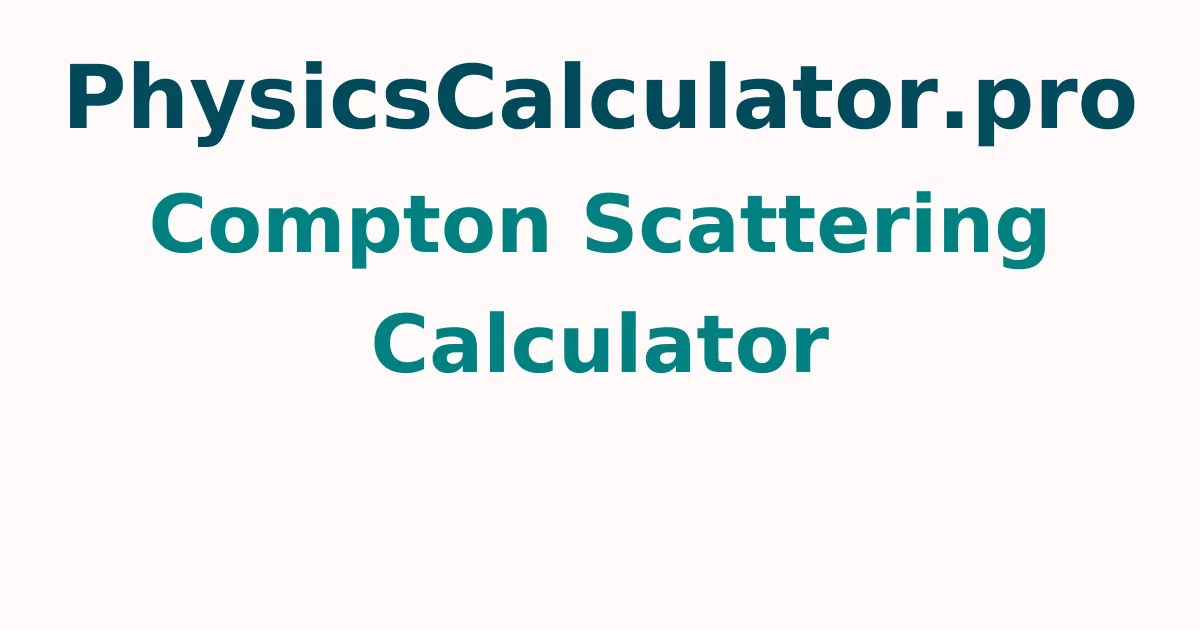Compton Scattering Calculator
You can use the Compton Scattering Calculator which is a web-based free online tool for calculating the wavelength extension of scattered photons. To get the result, simply enter the particle's mass and scattered angle details in the calculator's fields and press the calculate button
What is Compton Effect and Scattering Process?
One of the conceivable interactions between light and matter is the Compton effect. The photon's wavelength increases and its travelling direction changes as a result of this action. It's one of the phenomena that proves light's corpuscular nature.
A single photon can be thought of as a massless particle that carries energy based on its wavelength or frequency. When a photon collides with another particle, such as an electron, the direction in which it propagates can change.
For more concepts check out physicscalculatorpro.com to get quick answers by using this free tool.
Compton Scattering and Wavelength Extension Formula
A photon scatters off a free charged particle in an inelastic scattering phenomenon known as Compton scattering. Some of its energy is lost as a result. The recoiling particle receives the transferred energy.The Compton scattering is based on the premise that photons behave like particles and follow energy and momentum conservation laws.
The Compton scattering equation can be used to calculate the wavelength difference between scattered and incident light:
Δλ = h/(me*c)*(1-cos(θ))
- The Planck constant,h = 6.62607*10-34J/s
- λ be the wavelength
- m be the mass of a particle,
- me is the electron rest mass
- c be the speed of light, Its value is c = 299792458 m/s
- θ is the angle between the directions of scattered and incident rays.
The Compton wavelength of the item that generates the scattering is h/(m*c).
It is simple to do this for θ = 180°, which equals two Compton wavelengths, the most substantial extension of photon wavelength occurs, whereas for θ = 0°.There is no power loss, which corresponds to no scattering effect.
Applications of Scattering
Compton scattering:Compton scattering is crucial to radiobiology because it is the most likely interaction of gamma rays and high-energy X-rays with atoms in live organisms, and it is used in radiation therapy.
Compton Scattering by Magnets:The magnetisation of a crystal sample hit with high energy, circularly polarised photons is used in magnetic Compton scattering, which is an extension of the previously described approach.
Inverse Compton Scattering: In astrophysics, inverse Compton scattering is crucial. The accretion disc surrounding a black hole is thought to provide a thermal spectrum in X-ray astronomy.
Inverse Non-Linear Compton Scattering: Inverse non-linear Compton scattering (NICS) is the scattering of several low-energy photons in a high-energy photon (X-ray or gamma ray) upon interaction with a charged particle, such as an electron, caused by a strong electromagnetic field.
Compton Scattering Examples
Question 1: Calculate the wavelength extension of a photon scattered by an angle of 80 degrees on a free electron. If the mass is 9.15 x 10-31 kg, calculate the wavelength extension.
Solution:
Consider the problem, we have
Mass of the particle, m = 9.15x10-31kg
θ=80°
We Know that,The wavelength Extension Formula is Δλ = h/(me*c)*(1-cos(θ))
Δλ = 6.62607x10-34/(9.15 x 10-31x 299)x(1-cos80°)
Therefore, the wavelength extension of a photon is 2.004 pm
FAQs on Compton Scattering Calculator
1. What is Compton Scattering, and how does it work?
The Compton scattering is the scattering of photons by charged particles. Inverse Compton scattering occurs when a charged particle transfers some of its energy to a photon.
2. What role does the Compton effect play?
The significance of Compton's effect is that it reveals that light cannot be explained just as a wave phenomena. To explain low-intensity Compton scattering, the classical theory of an electromagnetic wave can't describe low-intensity wavelength shifts since the radiation must behave like particles.
3. What is the formula for calculating Compton Scattering?
Divide the constant by the product of mass and light speed to get the Compton scattering wavelength. Multiply the result by 1 minus the angle between the incident and dispersed rays.
4. What is the significance of graphite in the Compton Effect?
Compton's explanation of the Compton change is that valence electrons are weakly bound into the atoms of the target material, graphite and behave like free electrons.
5. What is the difference between the Compton effect and the Compton shift?
Compton Shift is increase in X-ray or gamma-ray wavelength caused by the energy transfer that occurs when photons scatter in the Compton effect.
